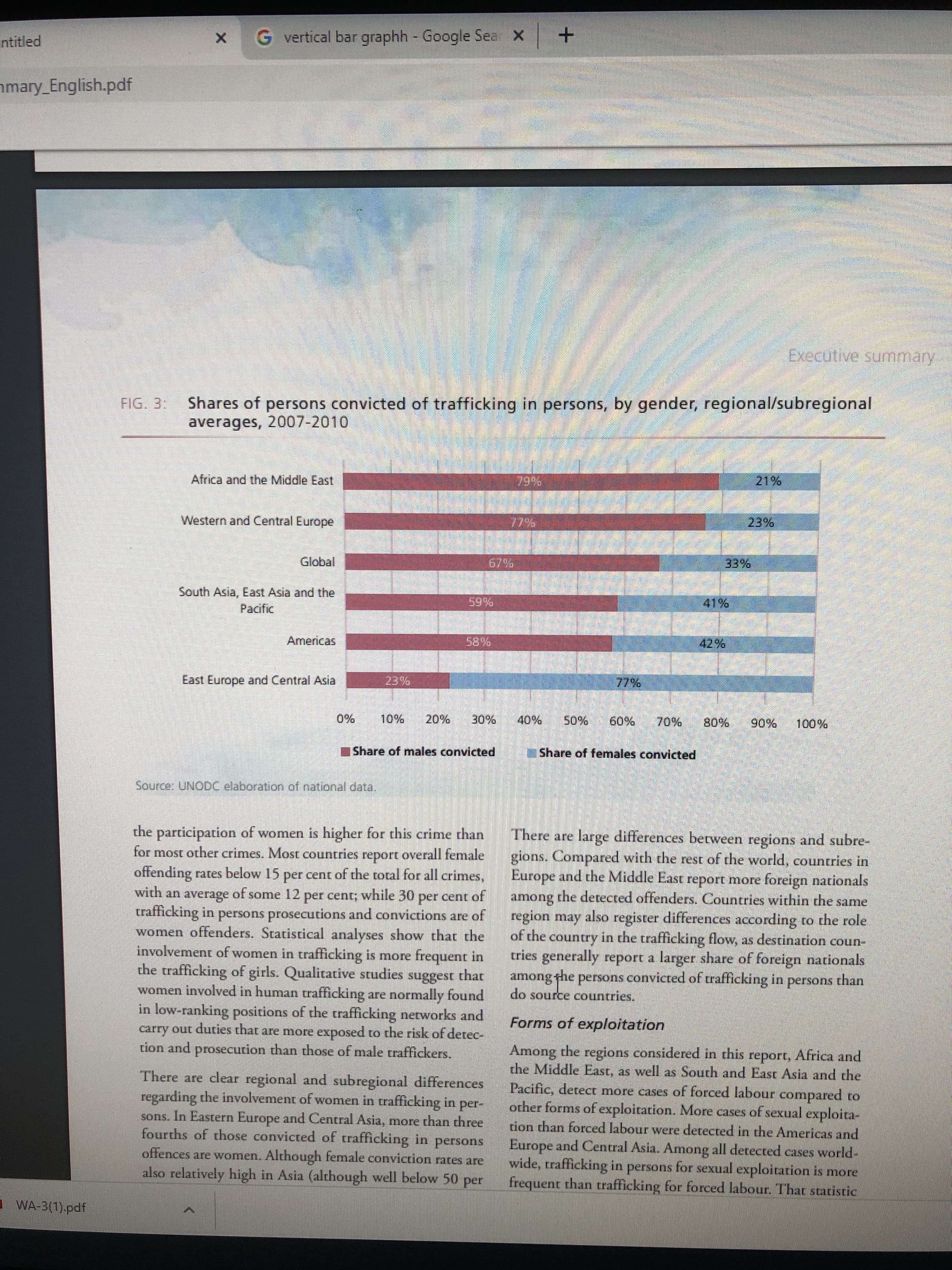ntitled G vertical bar graphh - Google Sea X amary_English.pdf FIG. 3: Shares of persons convicted of trafficking in persons, by gender, regional/subregional averages, 2007-2010 Africa and the Middle East 79% 21% Western and Central Europe 77% 23% Global 67% 33% South Asia, East Asia and the 59% 41% Pacific Americas 58% 42% East Europe and Central Asia 23% 77% 0% 10% 20% 30% 40% 50% 60% 70% 80% 90% 100% Share of males convicted Share of females convicted Source: UNODC elaboration of national data. the participation of women is higher for this crime than for most other crimes. Most countries report overall female offending rates below 15 per cent of the total for all crimes, with an average of some 12 per cent; while 30 per cent of trafficking in persons prosecucions and convictions are of women offenders. Statistical analyses show that the involvement of women in trafficking is more frequent in the trafficking of girls. Qualitative studies suggest that women involved in human trafficking are normally found in low-ranking positions of the trafficking networks and carry out duties that are more exposed to the risk of detec- tion and prosecution than those of male traffickers. There are large differences between regions and subre- gions. Compared with the rest of the world, countries in Europe and the Middle East report more foreign nationals among region may also register differences according to the role of the country in the trafficking flow, as destination coun- tries generally report a larger share of foreign nationals among the persons convicted of trafficking in persons than do source countries. the detected offenders. Countries within the same Forms of exploitation Among the regions considered in this , Africa and the Middle East, as well as South and East Asia and the Pacific, detect more cases of forced labour compared co other forms of exploitation. More cases of sexual exploita- tion than forced labour were detected in the Americas and report, There are clear regional and subregional differences regarding the involvement of women in trafficking in per- sons. In Eastern Europe and Central Asia, more than three fourths of those convicted of trafficking in persons Europe and Central Asia. Among all detected cases world- wide, trafficking in persons for sexual exploication is more frequent than trafficking for forced labour. That statistic offences are women. Although female conviction rates are also relatively high in Asia (altchough well below 50 per I WA-3(1) pdf 3. Why would you say women in Eastern Europe (Graph in Fig. 3) are represented as having been prosecuted and convicted of human trafficking more often than men were? Explain. The United Nations web page https://www.unodc.org/unodc/en/data-and-analysis/glotip.html hosts the "Global Report on Trafficking in Persons" It includes an executive summary and country profiles
Addition Rule of Probability
It simply refers to the likelihood of an event taking place whenever the occurrence of an event is uncertain. The probability of a single event can be calculated by dividing the number of successful trials of that event by the total number of trials.
Expected Value
When a large number of trials are performed for any random variable ‘X’, the predicted result is most likely the mean of all the outcomes for the random variable and it is known as expected value also known as expectation. The expected value, also known as the expectation, is denoted by: E(X).
Probability Distributions
Understanding probability is necessary to know the probability distributions. In statistics, probability is how the uncertainty of an event is measured. This event can be anything. The most common examples include tossing a coin, rolling a die, or choosing a card. Each of these events has multiple possibilities. Every such possibility is measured with the help of probability. To be more precise, the probability is used for calculating the occurrence of events that may or may not happen. Probability does not give sure results. Unless the probability of any event is 1, the different outcomes may or may not happen in real life, regardless of how less or how more their probability is.
Basic Probability
The simple definition of probability it is a chance of the occurrence of an event. It is defined in numerical form and the probability value is between 0 to 1. The probability value 0 indicates that there is no chance of that event occurring and the probability value 1 indicates that the event will occur. Sum of the probability value must be 1. The probability value is never a negative number. If it happens, then recheck the calculation.
question 3


Trending now
This is a popular solution!
Step by step
Solved in 2 steps




